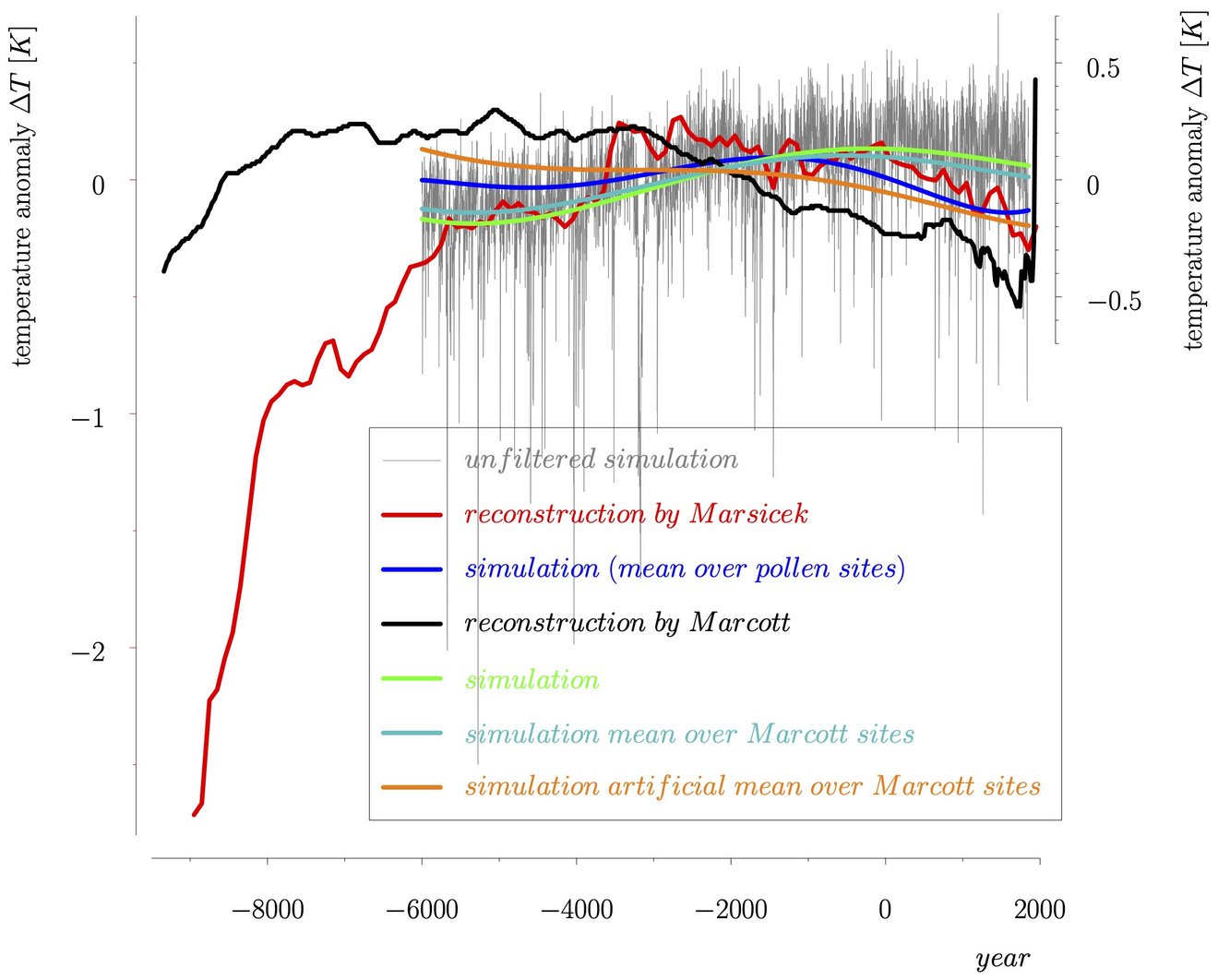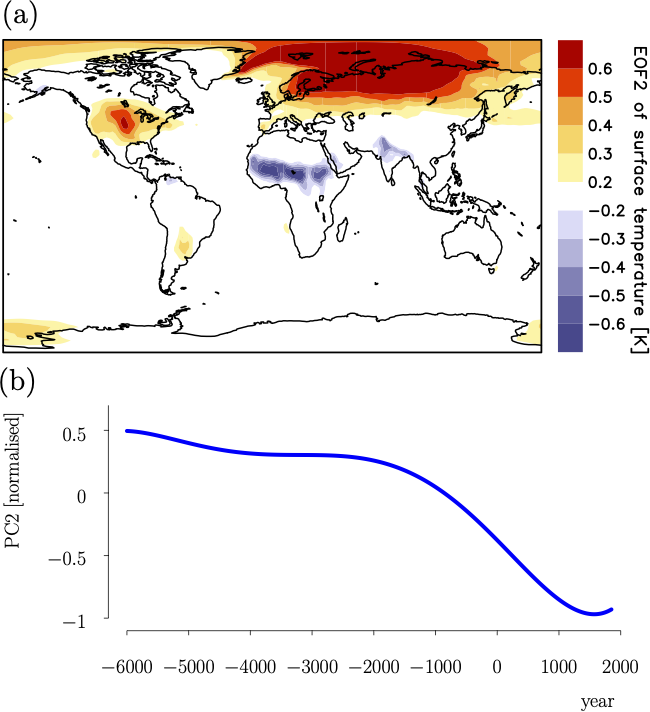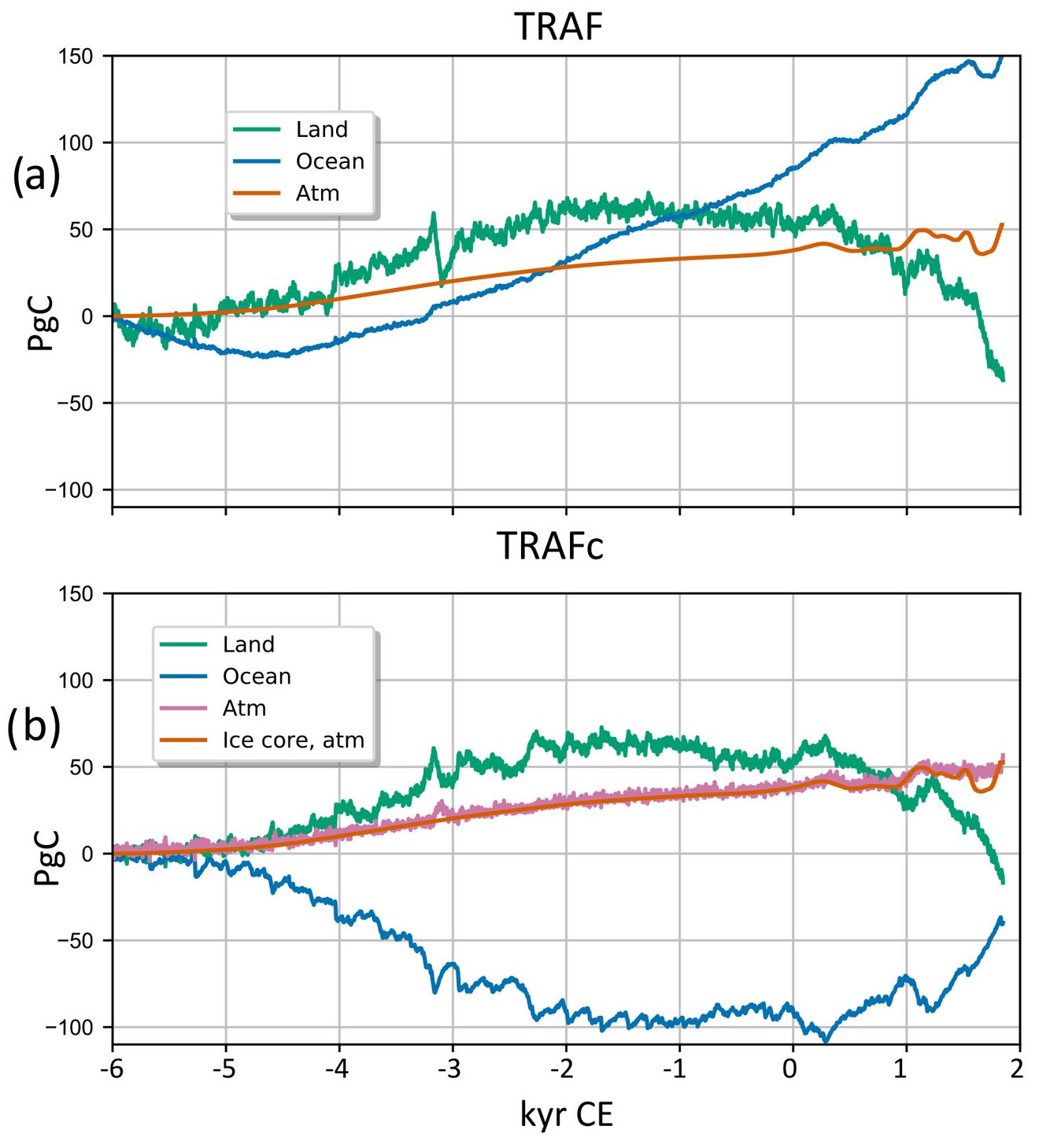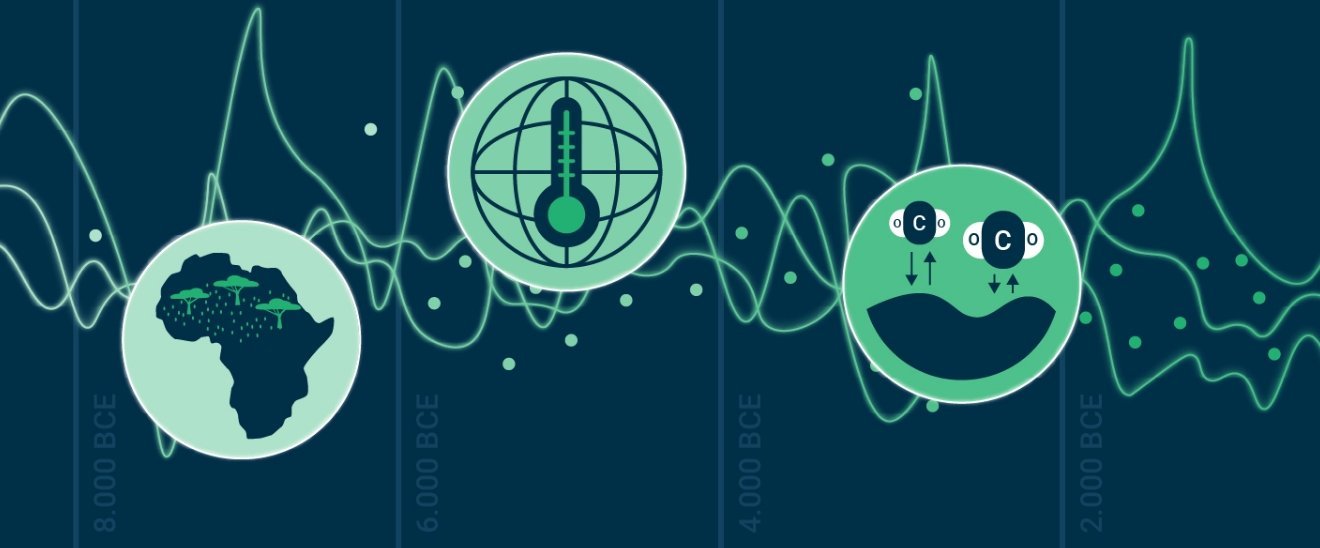Variability of the Earth system over the last 8000 years
With the development of new climate models and the ever-increasing computing capacities, it is now possible to perform transient model simulations over several thousand years with a geographical level of detail that is also used to calculate the IPCC climate scenarios. Here, transient means that the models are driven with time-varying boundary conditions. A distinction is made between slow and fast (external) forcings acting on the climate system from the outside. The solar radiation due to changing Earth orbital parameters and a weak CO2 increase are slow forcings; volcanoes and short-term changing solar radiation ("flickering") are fast forcings. The research focuses on the questions: What role do these forcings play in climate? How large is the contribution of the various external forcings to climate variability, and how do the feedbacks between internal components of the climate system affect climate variability? For understanding past climate changes are one way to examine the performance of climate models in reproducing different climates and to evaluate the performance of models outside of the climate variability currently observed today. In particular, the mid-Holocene period provides an opportunity to evaluate simulations for a time when substantially different seasonal conditions prevailed.
The simulations and model evaluations for the study of the paleoclimate were carried out within the Holocene project at the Max Planck Institute for Meteorology (MPI-M). About twenty scientists from all three departments of the MPI-M, the University of Hamburg and the Helmholtz Centre for Ocean Research in Kiel (GEOMAR) were involved. The following research questions were focused on:
- How does the Earth's climate system in the Holocene respond to (slow) orbital forcing, (fast) solar and volcanic forcing, and the weak CO2 increase?
- How do these forcing factors manifest themselves in climate variability compared to the variability that the climate system generates internally, by itself?
- How does fast forcing affect climate variability in the Holocene (compared to slow forcing)?
- Why has atmospheric CO2 concentration increased? To what extent can CO2 dynamics in the Holocene be reproduced?
Experiments
The core of the coordinated experiments consisted of transient simulations with the MPI-M Earth System Model (MPI-ESM) over the Holocene period of the last 8000 years. The experiments were computed at relatively high horizontal resolution over several millennia. The horizontal resolution was 1.875° in the atmosphere and 12 to 180 km in the ocean. The model forcing included recent compilations of reconstructed forcings of the transient Holocene climate: atmospheric greenhouse gas concentrations (CO2, CH4, N2O) and stratospheric volcanic aerosol distribution, variations in solar spectral radiance and stratospheric ozone, as well as forcing by orbitally triggered changes in solar radiance and land use changes. In addition to a "baseline" Holocene simulation using only orbital, greenhouse gas, and land use forcing, other experiments were conducted using reconstructions of volcanic eruptions from ice cores from Greenland and Antarctica and solar radiative forcing during the Holocene. Various sensitivity experiments were conducted around these experiments to decipher the role or contribution of individual forcing factors such as Earth orbital parameters, CO2, and land use change.
In the following, we discuss the results presented in the publications within the Holocene project by MPI-M scientists Dr. Jürgen Bader, Prof. Victor Brovkin, and Dr. Anne Dallmeyer, and their co-authors (Bader et al. (2020), Brovkin et al. (2019), and Dallmeyer et al. (2020)).
Climate dynamics - The puzzle of global temperature evolution over the last 8000 years
Bader et al. (2020)
One of the current topics in climate research is the evolution of global mean temperature over the last several thousand years, the period from the so-called early and middle Holocene, from about 11000 to 4200 years ago, to the late Holocene, the present time. Geological reconstructions of the evolution of global mean annual temperature during this period produce contradictory and puzzling results. A temperature reconstruction, based primarily on ocean sediments, shows warm conditions in the early to mid-Holocene, followed by a cooling trend toward the late Holocene. However, the other reconstruction based on pollen data suggests global warming until about the beginning of our era.

Bader et al. (2020) have shown that the seemingly opposing views can be reconciled using climate models. They use global spatiotemporal temperature variability in a transient Holocene simulation over the period from 6000 years B.P. to the pre-industrial epoch (1850).

The results show that both a global warming mode and a cooling mode occur. The warming mode is mainly related to the combined effect of a small but significant increase in greenhouse gases of about 20 ppm and the latitude-dependent trend in mean annual orbitally driven solar radiation. It is most pronounced in the tropics. The simulated cooling mode - similar to the global cooling trend in a reconstruction - is driven by changes in the seasonal cycle of Arctic sea ice forced by orbital variations and volcanic eruptions. This mode primarily affects the Arctic, North Atlantic, and Eurasian regions. The heating mode dominates in the mid-Holocene, while the cooling mode prevails in the late Holocene. Furthermore, the weighted sum of the two modes results in the simulated global temperature trend evolution during the Holocene.
Experiments with different external forcing factors show a substantial effect of higher-frequency variability of external forcing variables - such as volcanoes - on the trend development of global temperature in the Holocene. These results provide valuable information for the interpretation of geologic records used to estimate past climate changes. These, in turn, contribute to our understanding of the environmental changes in which human civilizations evolved.
Transient regional vegetation changes - The end of the African humid period
Dallmeyer et al. (2020)
Increased solar radiation in the northern hemisphere in summer during the early and mid-Holocene led to increased precipitation and widespread vegetation expansion in the Sahara during the African Humid Period (AHP). While changes in atmospheric dynamics during this period have been a major focus of paleoclimate modeling efforts, the transient nature of the return to the current desert state at the end of this period is less well understood. Reconstructions show a spatially and temporally complex end of the AHP, with an earlier end in the north than in the south and in the east than in the west. Some records suggest a fairly abrupt end, while others indicate a gradual decline in moisture availability.

Dallmeyer et al. (2020) examined the end of the AHP using the MPI-ESM transient simulation described previously. The model largely reproduces the time-transgressive end of the AHP evident in the proxy data and suggests that it is due to regionally varying precipitation dynamics. The effects of the major rainfall-producing systems, the summer monsoon and extratropical troughs, vary spatially. This leads to heterogeneous seasonal precipitation cycles that force regionally different responses to the decrease in solar radiation during the Holocene. An increase in extratropical troughs interacting with the tropical mean flow and transporting moisture to the Western Sahara during the mid-Holocene delays the end of the AHP in this region. Along the coast, this interaction maintains moist conditions longer than further inland. Aridification in this area sets in when this interaction becomes too weak to sustain precipitation. In the lower latitudes of West Africa, where precipitation is influenced only by the dynamics of the summer monsoon, the end of the AHP coincides with the retreat of the monsoon rain belt. The model results clearly show that non-monsoonal dynamics can also play an important role in the formation of the precipitation signal and therefore should not be neglected in the analysis of North African precipitation trends.
Carbon cycle dynamics - Where did the CO2 for the atmospheric CO2 rise during the Holocene come from?
Brovkin et al. (2019)
Atmospheric CO2 concentrations increased by about 20 ppm from 6000 BC to pre-industrial times (1850). Several hypotheses have been proposed to explain the mechanisms of this CO2 increase, based on either ocean or land carbon sources. Brovkin et al. (2019) also use the MPI-ESM-LR Earth system model for two transient simulations of climate and carbon cycle dynamics with all forcings during this period. In the first simulation, atmospheric CO2 from ice core data is also prescribed. In response to increasing atmospheric CO2 concentrations, carbon storage on land increases until 2000 B.P., stagnates thereafter, and decreases in present time, while the ocean continuously absorbs CO2 from the atmosphere after 4000 B.P. This results in a missing source of 166 petagrams (Pg) of carbon in the ocean-land-atmosphere system at the end of the simulation.

In the second experiment, a CO2 nudging technique was used in which the surface alkalinity of the ocean, i.e., the acid-binding capacity at the surface, was forced to follow the reconstructed CO2 concentration while the carbon cycle remained interactive. In this case, the ocean is a source of CO2 from 6000 to 2000 before present due to a decrease in the surface alkalinity of the ocean. In the prescribed CO2 simulation, the surface alkalinity is also decreasing. However, it is not enough to make the ocean a CO2 source. The carbonate ion concentration in the deep Atlantic is decreasing in both the prescribed and interactive CO2 simulations, while the magnitude of the decrease in the prescribed CO2 experiment is underestimated compared to the available proxy data. Since the land serves as a carbon sink until 2000 before present due to natural carbon cycling processes in both experiments, the missing carbon source for land and atmosphere can only be attributed to the ocean. Within the model framework, an additional mechanism, such as decreases in surface alkalinity, e.g., due to unaccounted for processes of carbonate accumulation on ice shelves, is required for consistency with the ice core CO2 data. Consequently, the simulations support the hypothesis that the ocean was a source of CO2 until the late Holocene, when anthropogenic sources of CO2 began to influence atmospheric CO2.
Outlook
The model simulations for the Holocene project have been completed. The evaluation is still going on, as mentioned above. Thus, an analysis of the changes in the calculated global vegetation patterns is pending. In the area of North Africa, we will investigate the rapid change in the extent of the Sahara calculated by the model, which was abrupt in some regions, and compare it with reconstructions.
Original publications
Bader, J., J. Jungclaus, N. Kritova, S. Lorenz, A. Maycock, T. Raddatz, H. Schmidt, M. Toohey, C.-J. Wu and M. Claußen (2020) Global temperature modes shed light on the Holocene temperature conundrum. Nature Communications.https://doi.org/10.1038/s41467-020-18478-6
Brovkin, V., S. Lorenz, T. Raddatz, T. Ilyina, I. Stemmler, M. Toohey, and M. Claussen (2019) What was the source of the atmospheric CO2 increase during the Holocene? Biogeosciences, 16, 2543-2555. https://doi.org/10.5194/bg-16-2543-2019
Dallmeyer, A., M. Claussen, S. Lorenz, and T. Shanahan (2020) The end of the African humid period as seen by a transient comprehensive Earth system model simulation of the last 8000 years. Climate of the Past, 16, 117-140. https://doi.org/10.5194/cp-16-117-2020
Contact
Dr. Jürgen Bader
Max Planck Institute for Meteorology
Email: juergen.bader@mpimet.mpg.de
Prof. Dr. Victor Brovkin
Max Planck Institute for Meteorology
Email: victor.brovkin@mpimet.mpg.de
Prof. Dr. Martin Claußen
Max Planck Institute for Meteorology
Email: martin.claussen@mpimet.mpg.de
Dr. Anne Dallmeyer
Max Planck Institute for Meteorology
Email: anne.dallmeyer@mpimet.mpg.de
Dr. Johann Jungclaus
Max Planck Institute for Meteorology
Email: johann.jungclaus@mpimet.mpg.de

